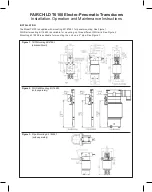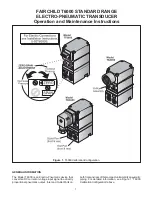
DW1000 User Manual
© Decawave Ltd 2017
Version 2.12
Page 72 of 242
Field
Description of fields within Register file: 0x04 – System Configuration
DIS_RSDE
reg:04:00
bit:14
Disable Receiver Abort on RSD error. During normal reception (i.e. with the DIS_RSDE bit
cleared to its recommended default zero value) when the Reed Solomon decoder detects
an non-correctable error then frame reception is aborted and the receiver will be disabled,
(unless the RXAUTR control bit is set in which case the receiver will automatically re-enable
and begin preamble hunt again). The Reed Solomon decoder error is generated when an
error is found that cannot be corrected using the Reed Solomon FEC (forward error
correction) data. The Reed Solomon decoder error is flagged in the RXRFSL event status bit
in
Register file: 0x0F – System Event Status Register
. When the DIS_RSDE bit is set the
receiver will not abort reception when the Reed Solomon error occurs, but will instead
continue to demodulate the data to the end of the frame (i.e. for the length specified in the
PHY Header). Typically the non-correctable Reed Solomon error will mean that the frame is
corrupted and that the CRC will not be correct.
FCS_INIT2F
reg:04:00
bit:15
This bit allows selection of the initial seed value for the FCS generation and checking
function that is set at the start of each frame transmission and reception. By default the
FCS_INIT2F bit is 0 selecting the FCS generation/checking seed initialisation to be all zero
(0x0000) – this is the standard setting required for IEEE 802.15.4 compliance. When the
FCS_INIT2F bit is 1 the FCS generation/checking initialisation value will be all ones (0xFFFF).
PHR_MODE
reg:04:00
bits:17,16
This configuration allows selection of PHR type to be one of two options. The default
setting gives IEEE standard PHR encoding and a maximum data payload of 127 octets. The
other option enables the proprietary long frames mode which allows a data payload of up
to 1023 octets. In this mode the PHR encoding does not follow the IEEE standard. For
successful communications between two nodes both must be configured for the same PHR
mode. Supported PHR_MODE configurations are:
00 – Standard Frame mode. Use this setting is for IEEE 802.15.4 compliance.
11 – Long Frames mode. Proprietary PHR encoding. Frame Length 0-1023.
DIS_STXP
reg:04:00
bit:18
Disable Smart TX Power control.
Smart TX power control applies at the 6.8 Mbps data rate. When sending short data frames
at this rate (and providing that the frame transmission rate is < 1 frame per millisecond) it is
possible to increase the transmit power and still remain within regulatory power limits
which are typically specified as average power per millisecond.
When DIS_STXP is 0, the transmitter automatically sets the transmitter power levels when
sending a frame at the 6.8 Mbps data rate, depending on the frame length specified in the
TFLEN field of
Register file: 0x08 – Transmit Frame Control
The actual power levels used are selected by the values configured in
, described in section 7.2.31.
NB: It is up to the external system to keep the frame rate below 1 frame per millisecond to
ensure that the power boost is not breaking the regulations.
When DIS_STXP is 1, the smart TX power control function is disabled and TX power does not
depend on data rate and frame length. In this case the values configured in
are used to specify the power in different phases of the TX
frame separately, see section 7.2.31.
-
reg:04:00
bits:21–19
These bits are reserved and should always be set to zero to avoid any malfunction of the
device.
















































